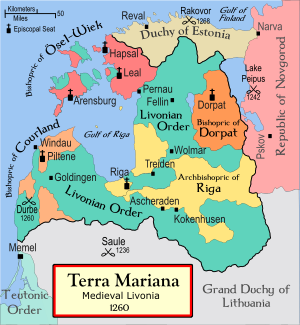Battle of Aizkraukle
| Battle of Aizkraukle | |||||||
|---|---|---|---|---|---|---|---|
| Part of the Livonian Crusade | |||||||
 Livonia in 1260, showing the location of Ascheraden (Aizkraukle) | |||||||
| |||||||
| Belligerents | |||||||
| Grand Duchy of Lithuania | Livonian branch of the Teutonic Order | ||||||
| Commanders and leaders | |||||||
| Traidenis |
| ||||||
| Casualties and losses | |||||||
| Unknown | 71 knights killed | ||||||
The Battle of Aizkraukle or Ascheraden was fought on 5 March 1279 between the
Danish Estonia, were killed.[2] It was the second-largest defeat of the order in the 13th century.[3][2] After the battle Duke Nameisis of the Semigallians recognized Traidenis as his suzerain.[4]
Background
In 1273 the order built
Daugava River and for influence in the Principality of Polotsk.[6]
Campaign and battle
The Livonian campaign, which opened in February 1279, involved a chevauchée into Lithuanian territory. The Livonian army included men from the Livonian Order,
Danish Estonia, and local Curonian and Semigallian tribes. At the time of the campaign, Lithuania suffered a famine and Traidenis' brother Sirputis raided Polish lands around Lublin.[6] The Livonian army reached as far as Kernavė, the center of the Grand Duke's lands. They did not meet any open resistance and plundered many villages. On their way home the knights were followed by a small force of Traidenis' troops. When the enemies approached Aizkraukle, the Grand Master sent most of the local warriors home with their share of loot. At that point the Lithuanians attacked. The Semigallians were one of the first to retreat from the battlefield and the Lithuanians achieved a decisive victory.[5]
Aftermath
The order lost its achievements over six preceding years: the Semigallians rebelled once again and submitted to Traidenis for protection.Teutonic Knights so that any future attacks would be carried out simultaneously from the west and north.[5]
References
- ISBN 978-1-57607-862-4.
- ^ a b c Gudavičius, Edvardas. "Aizkrauklės mūšis". Visuotinė lietuvių enciklopedija (in Lithuanian). Retrieved 3 November 2023.
- ^ Baranauskas, Tomas (2006-09-22). "Ar priminsime Europai apie Šiaulių mūšį?" (in Lithuanian). Delfi.lt. Retrieved 2007-05-26.
- ^ Jasas, Rimantas. "Nameisis". Visuotinė lietuvių enciklopedija (in Lithuanian). Retrieved 3 November 2023.
- ^ ISBN 0-929700-10-4.
- ^ ISBN 978-9955-847-12-0.
